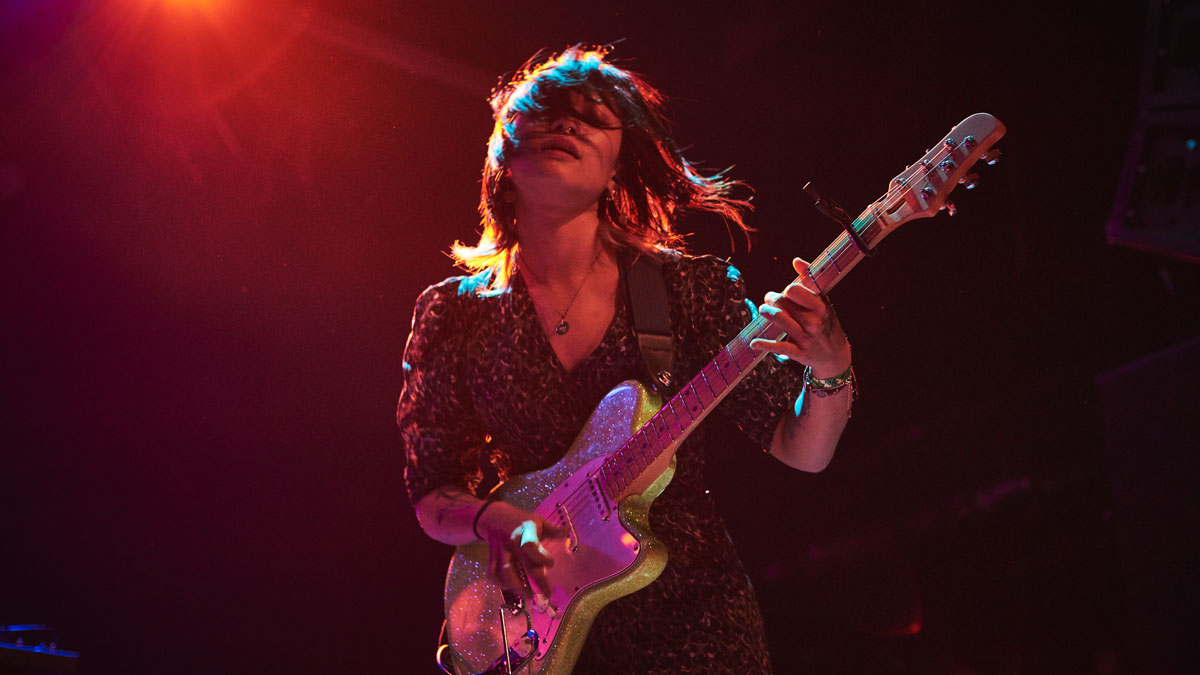Yvette Young: "I feel like an outsider to the whole virtuoso guitar world... I would jokingly call my genre 'detail rock'!"
The Covet leader and math-rock innovator goes deep on her Ibanez signature model, latest single Parachute, and how the guitar saved her life

“I know it sounds cheesy… but guitar really did save my life,” says Covet singer/guitarist Yvette Young, talking to Guitar World ahead of the release of the trio’s second full-length, Technicolor.
In the middle of an interview about the key instruments, amps and effects used on its 10 dazzling shoegazey tracks, she drops a bombshell on how her trusty six-string was there for her in her greatest time of need, giving her the strength and courage to ponder and eventually embrace a more positive future. It’s an incredibly powerful message to share.
“I didn’t take guitar seriously until I was in hospital, thinking I’d have to live there for a long time,” she continues. “I was really depressed about it and decided it would be a good outlet for me. I wrote some sad songs with lyrics and really started focusing on music.
“I was not in a good place but having a new instrument to teach myself was so empowering. It made me feel like I had a voice and gave me confidence. That’s what really pulled me out of that darkness… I took that with me through college and never looked back!”
The young Californian started out playing classical music on violin and piano from an early age, though by her own admission neither instrument had particularly resonated with her. She describes the switch to guitar many years later as arguably her greatest light-bulb moment, one which allowed her to delve deep into new worlds of self-expression and lose herself in the calmness of her own hypnotic noise.
Having now found her true calling, it wouldn’t take her long to start creating and performing, eventually establishing herself as one of the most exciting players of a new generation, fronting Covet. Her connection to her instrument is as personal as it gets. It would be her salvation…
“I grew up playing classical violin and piano, but I always associated that world with competitiveness, pressure and stress,” admits Young. “Piano and violin were things I did for other people - my parents kinda forced it on me - so the guitar felt very different. It’s a thing that no one else can touch, this amazingly personal outlet for me to express myself and explore.
Get The Pick Newsletter
All the latest guitar news, interviews, lessons, reviews, deals and more, direct to your inbox!
"I write what I want to write, and play what I want to play. There was something really liberating about picking up a new instrument, not learning the rules and just playing for fun. It’s been so good to me.”
Certainly there are numerous advantages, but what’s your absolute favorite thing about being a guitar player?
I don’t necessarily write with theory but I have the ear from my classical background, so I tend to write by ear
“Songwriting is my passion, I think. Above all else, I love composing music and using pedals to enhance that whole experience. It feels like a playground to me, while also being super meditative and therapeutic. I can lose myself in writing a riff for nine hours and forget to eat or go to the bathroom!
"I don’t necessarily write with theory but I have the ear from my classical background, so I tend to write by ear. I feel like an outsider to the instrument and whole virtuoso guitar world, but it’s a lot of fun. That said, I like Guthrie Govan a lot. He’s so versatile in how he writes. Melodically, he’s one of the most appealing guitarists out there.”
What do you remember about your earliest influences?
“I don’t think I ever listened to one individual player. I grew up going to shows and just seeing bands in general… I just loved that. Coming from a classical background, my parents were very strict and didn’t allow me to go to shows for a long time. So to me seeing punk and noise/math rock shows felt like a different, cool world of counter-culture.
"That’s what made me want to pick up the guitar. I started on an acoustic because I was listening to a lot of folk players like Cat Stevens, initially doing the whole fingerpicking thing...”

And then you got your first electric guitar...
“It’s so funny, my first one was a super cheap $90 SX Tele, but it was outfitted with really nice hand-wound pickups made by Bill Lawrence. I didn’t have the money for a guitar back then so I actually swapped it for my drum machine.
"I thought it was time for a change! I ended up playing it for a really long time… What I found really interesting about that guitar was the neck was actually alright, usually cheaper Teles - especially around $90 - don’t have necks that feel too great. This one was actually quite comfortable.”
Now, of course, you have your own signature Ibanez model. How did you initially become involved with the company?
“I was playing extended-range fanned-fret headless Strandbergs for a while because they approached me about doing a video. I’d never played an extended-range guitar before, so had to write a song on seven-string in a week and be ready to perform it.
Ibanez reached out saying, ‘No pressure, we know you are with Strandberg, but we’d love to send you a guitar’
"And then just from being on people’s radar, Ibanez reached out saying, ‘No pressure, we know you are with Strandberg, but we’d love to send you a guitar’ and I could ask for anything.
“So they made me this sparkly peach Tele-style Talman and I actually cannibalized the Bill Lawrence pickups from the SX Tele because I liked them so much. I don’t play that guitar live much because the pickups are a bit lower output than the Seymour Duncan Five-Twos that I have on my signature. That volume bounce is a little annoying to deal with, but I really love this guitar. It sounds amazing and I will bring it out again one day.”
What made you go for a lesser-known body like a Talman?
“Mike, my Artist Rep there, suggested it and originally I wasn’t sure if I wanted a metal guitar, because I’m not much of a metal player. And he explained they were discontinued but he thought I’d like the body shape and feel. As soon as I got it, the neck felt so fast – I think it’s a Wizard profile. That was my first taste of an Ibanez Talman.
"Then I remember at NAMM, I needed to borrow a guitar for a demo so I went to the Ibanez booth and he let me borrow my sunburst one. I did the demo and really loved it. The neck was different, it’s a Custom Shop neck, that wasn’t so glossy, it was super dry-feeling. I remember Mike handing me it back at the end of the day and telling me to just keep it.
“And I can’t explain it... I don’t know if it’s the paint job or the wood, but it’s my most inspiring guitar. For some reason, when I plug into that one I write a lot. Maybe it’s the neck, maybe it’s magic, maybe I’m crazy and just imagining things! Through playing those guitars, I realized I’m more of a traditional guitar player.
“As much as I love ergonomic fanned-fret things, they’re wonderfully built, though I still like having a bit of weight. I use a lot of clean tones and feel like there’s more sustain with more wood. I feel it while I’m playing.”
What other features were you looking for from your first signature?
“I knew it would definitely be a Talman with a really vivid color to catch people off the cuff… because everyone usually goes for nice colors. Mine is either an eyesore or it could be dope! That’s how I ended up with this sparkly green finish that looks like it’s from Nickelodeon. I kinda sticker-bombed it.
"The guitar actually comes with a custom sticker pack that I designed, because I’m primarily a visual artist. I went to school to study art, I never thought I’d be doing music, and this felt like a way of tying both worlds.
My primary goal was to make music a fun, light-hearted thing for people. It’s easy to get deterred by not being technical or flashy enough
“I know a lot of my demographic is younger punk and indie fans, and in those circles people usually customize their guitars. I wanted to give them an opportunity to do that if they wanted to. It has a U-Shape neck profile, a bit thicker than the Prestige models I have but I don’t necessarily mind that. Some people prefer thicker necks, I usually prefer thin necks, so this one is a nice middle-ground.
"My primary goal was to make music a fun, light-hearted thing for people. It’s easy to get deterred by not being technical or flashy enough, to go online and get intimidated by all these people killing it. I wanted to make a guitar that sounded automatically great as soon as you plug it in and hope people will feel encouraged to write their own music on it.”
Are you still mainly using Vox amps?
“Yes, my main amp at home for my demoes - and actually in the studio this time - is a Vox AC10. My first amp was ever the four-watt AC4TV, which is also a tube amp, so they’re what I’ve always played through. Maybe it’s out of habit or weird loyalty but they so suit what I do…
"I love pushing them just a little bit, so it’s clean when I lay back but breaks up a bit when I dig in. I really depend on my fingers dynamically because I don’t use a pick, so I don’t have a lot of attack. It can actually be more forgiving in a lot of ways, because I can really control the dynamics. It’s a little harder to lay back with a pick sometimes.”
What made you decide to play electric guitar completely fingerstyle?
“I think it came from my piano background. I had the finger independence and dexterity from those days, so playing without a pick felt better to me. I was already so used to working with my fingers and controlling them, and picks always felt like a weird, artificial extension of my hand. I couldn’t quite get the polyphony that I liked. You can get a lot of detail using fingerstyle, with counterpoints in your playing, which are more difficult with a pick.
“So I just gravitated to the whole two-handed tapping, fingerstyle sort of thing. A lot of bands I listened to did that. There’s a British band called TTNG who are really cool and math-y.
"I listened to them a lot growing up and really liked their guitarist Tim Collis, who used a lot of fingerstyle. That’s where it came from. I never really wanted to do the powerchord stuff. I guess I would jokingly call my genre ‘detail rock’ (laughs)!”
There a lot of effected guitars on the new album - what were your main tools for the recordings?
My favorite effect of all is chorus/vibrato. Anything with that modulated, warbly sound I love
“The Meris Mercury7 is my favorite reverb in the whole world because it has this pitch down feature where you play a note and it sounds like bombs dropping, a bit like Godspeed You! Black Emperor. It’s such a great ambient pad sound. Just one big hit and the sustain drops and overlaps into what you play next. I also have an MXR Carbon Copy Deluxe, which is a great analog delay.
“I use The Warden, a compressor from EarthQuaker... I have to say it’s been pretty instrumental in getting a lot of variation in my tones. The way the compressor works with other effects is amazing, you can really toy with it and change you sound - if you push into driven sounds by cranking the sustain knob without any overdrive pedal. It’s very cool.
"I also have a Walrus Audio Julia, which is an amazing chorus. My favorite effect of all is chorus/vibrato. Anything with that modulated, warbly sound I love. There’s also a Caroline Somersault Lo-Fi Modulator and then my primary gain pedal this time was the Longsword made by Electronic Audio Experiments, who are an indie brand.”

You use some altered tunings to help get more mileage out of your two-handed approach. Which are you favorites?
“I used to use way more tunings but for the sake of my sanity and memorizing shapes I’ve been using less. I actually don’t memorize chord shapes at all. When I write a riff, I hum it and hear the harmonies, then teach it to myself really slowly. It’s not like I’m in there banging out riffs, I have to piece it together meticulously.
“Certain tunings assist with that, they can make certain interval stretches a little easier and more accessible. Some people might say that’s cheating but it’s not at all - why would you not want to do the exact thing you hear in your head. My main alternate tunings on this album were just DADF#AE and FACGBE, or very slight variations, because I probably couldn’t memorize it all...”
Well, those open strings definitely seem to come in handy!
“For me, I just want to find music that moves me emotionally. Melody is always the primary focus, so the unusual tunings assist me in filling out those melodies. I use a lot of open strings, as well as playing bass patterns at the same time as a more leady guitar line.
My rule in music is don’t rule anything out. If you hear something it and the song needs it, then do it
"I’m used to playing like a bedroom guitarist! When I didn’t have a band, having those open tunings and implying bass parts was really helpful. It filled out my sound a lot. That’s how I ended up writing what I write.”
You recently posted a playthrough of a new song, Parachute, which interestingly also features some vocals...
“It’s one of the more simple ones and a rare song that just came together in one sitting. The universe was like, ‘Here’s your song!’ so it wasn’t much of a struggle. There’s a little sweep run in there and whenever I play it live, I’m always thinking to myself, ‘Don’t fuck it up!’ It’s the most unnerving part of the song. I love the chords at the end, they feel really dense and heavy, though not Cattle Decapitation heavy. I used a lot of chorus, it’s one of our more indie tracks...
“And yup, I sing on it! Our past stuff was purely instrumental except for my solo projects. My rule in music is don’t rule anything out. If you hear something it and the song needs it, then do it. It’s whatever serves the music. I’m a slave to music (laughs)! I heard vocals in this one and thought to myself, ‘I guess we’re not an instrumental band anymore!’”
Covet's new album Technicolor is out on June 5 via Triple Crown Records.
Amit has been writing for titles like Total Guitar, MusicRadar and Guitar World for over a decade and counts Richie Kotzen, Guthrie Govan and Jeff Beck among his primary influences as a guitar player. He's worked for magazines like Kerrang!, Metal Hammer, Classic Rock, Prog, Record Collector, Planet Rock, Rhythm and Bass Player, as well as newspapers like Metro and The Independent, interviewing everyone from Ozzy Osbourne and Lemmy to Slash and Jimmy Page, and once even traded solos with a member of Slayer on a track released internationally. As a session guitarist, he's played alongside members of Judas Priest and Uriah Heep in London ensemble Metalworks, as well as handled lead guitars for legends like Glen Matlock (Sex Pistols, The Faces) and Stu Hamm (Steve Vai, Joe Satriani, G3).
Ozzy Osbourne’s solo band has long been a proving ground for metal’s most outstanding players. From Randy Rhoads to Zakk Wylde, via Brad Gillis and Gus G, here are all the players – and nearly players – in the Osbourne saga
“I could be blazing on Instagram, and there'll still be comments like, ‘You'll never be Richie’”: The recent Bon Jovi documentary helped guitarist Phil X win over even more of the band's fans – but he still deals with some naysayers














